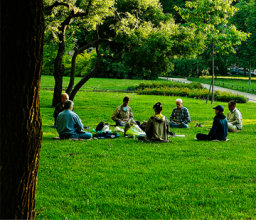Do you know the myths about mindfulness and what is true or false about this swelling revolution? Take a look at what I think are the top 5 myths about mindfulness.
Myth: Mindfulness is for taking a time-out from life, quieting the mind and reducing stress.
I think this is the #1 myth out there because it’s my experience that this is how people initially experience the practice. One of the greatest entry points to mindfulness in the West is Mindfulness-Based Stress Reduction (MBSR). This is a fantastic program with wonderful science behind it, but the name is just for marketing. The ultimate goal isn’t meant to be stress reduction. The goal of mindfulness and MBSR is to wake up to the inner workings of our mental, emotional, and physical processes, recognize the connectedness between people, and operate in the world with greater compassion towards others and ourselves.
However, the initial practices can often give people a sense of relief from a busy mind and can then be equated with a mental break. While there’s nothing wrong with using it this way, it also minimizes the power of mindfulness.
The paradox here is when we’re able to just be present to our minds, emotions, and bodies, the stressful relationship tends to quiet down—but when we try and quiet the mind down, we often add fuel to the fire.
Myth: You need to carve out plenty of time in a serene “mindful” space.
Mindfulness can be practiced in many ways. Your personal circumstances should dictate what works for you. There is no single right way to do it. If you struggle to artificially jam meditation into your day, it will become an unpleasant tug of war. In the end, marrying meditation with your life is a matter of balance.
There are many people who intentionally carve out time in their day to sit and practice a formal mindfulness meditation: learning a basic mindfulness meditation such as following the breath and practicing it on a regular, preferably daily, schedule. These are doctors, lawyers, teachers, police officers, grocery store clerks, sports players, and even some politicians.
There are also many people who dedicate their lives to an informal practice of being curious and present in the things they’re already doing. This might include coming to the senses in the shower, intentionally listening to people with curiosity, taking a mindful run, or being present to comfortable and uncomfortable feelings off and on throughout the day.
In my experience, it helps to have both a formal practice of mindfulness and informal practices that extend mindfulness into everyday life. As the 15th century Indian poet Kabir said, “Wherever you are that’s the entry point.”
In other words, make it your way and just get started.
Myth: It’s about focusing or concentration.
While the benefit of increasing the ability to concentrate and focus can come from your mindfulness meditation practice, it is certainly not about focusing and concentration. Remember, mindfulness is about cultivating awareness. Concentration can be an important skill to cultivate for our well-being, but it is not mindfulness.
You can be sitting in meditation focusing on the breath and have your mind wander off hundreds of time. The fact that it wanders doesn’t mean you are unmindful. In fact, every time you notice your mind has wandered, you are present, in a state of mindfulness. In that space, there’s the choice to gently bring attention back.
Mindfulness is awareness. In one moment you were mindful of a wandering mind, in the next you were mindful of the breath. Both involve awareness.
Myth: Mindfulness is for people who are relaxed.
I’ve been leading groups for almost a decade in mindfulness and most of the people who walk through the door are far from relaxed. But by the time the course is over, many of them feel they have gained an internal sense of control and are able to ride the turbulence with greater ease. In fact, I can make the argument that people who find themselves the most restless have the most to gain from integrating the principles and practice of mindfulness into their lives.
This doesn’t mean mindfulness makes us calm, but it can ingrain a greater flexibility of mind that can be grateful for the good moments and graceful during them more difficult ones.
Myth: Mindfulness teachers are always mindful.
Let me be the first to debunk this myth from a personal experience. I am a mindfulness teacher, have led and practiced countless meditations, but can find myself in plenty of mindless moments. I also have many friends who are mindfulness teachers (many who you would know by name) and have witnessed these same mindless moments among them. In fact, the reason many mindfulness teachers are drawn to mindfulness is to help facilitate a troubled mind.
Don’t get me wrong, the practice has been extraordinarily helpful to me in so many ways personally, in my relationships with my kids, and professionally. In fact, one of the most helpful places it comes up for me is in my mindless moments as it helps me wake up to them sooner with greater self-compassion.
Myth: Mindfulness can ultimately make the world a better place.
Well, there was only five myths and this one actually has some credibility to it ;). As Thich Nhat Hanh says, “Peace in oneself, peace in the world.”
From: Mindful

